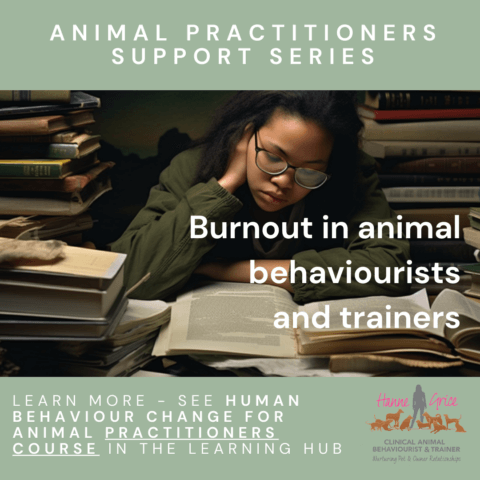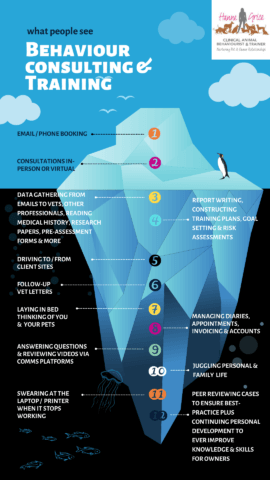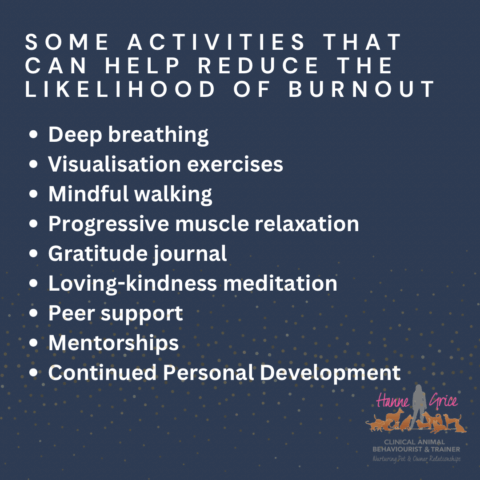
This article is aimed at animal practitioners to help them better understand burnout, how it occurs and how to avoid it.
As animal behaviourists and trainers, we play a crucial role in enhancing the well-being of animals and fostering harmonious human-animal relationships. However, the demanding nature of our work can lead to burnout, a state of physical and emotional exhaustion. Burnout affects professionals in various fields, and although compassion fatigue and burnout have been explored in the context of other caring professions including the veterinary profession, research is limited when it comes to animal behaviourists and trainers. Data highlights that beyond the psychological and physiological costs of burnout to the individual, there is a monetary cost too – burnout of US veterinarians is said to be around $1 to 2 billion annually, in lost revenue (Neill et al., 2022).
Understanding burnout
Burnout is a psychological condition that arises from chronic workplace stress. It is characterised by emotional exhaustion, depersonalisation, and reduced personal accomplishment. As animal behaviourists and trainers, we often face demanding workloads, emotional strain, and long working hours, which can contribute to burnout. Much of our work includes working with challenging cases, dealing with difficult animal behaviours, meeting and overcoming resistance whether that is with clients, colleagues and or peers, and we often work in unpredictable environments, all of which can take a toll on well-being.
Consequently, key factors that contribute to burnout in the animal behaviour and training sector include

- Emotional intensity: Where working closely with animals and their caregivers, we often deal with emotionally charged situations. This might include recommendations for rehoming, supporting highly distressed and or demotivated owners, discussing with the caregiver and veterinary surgeon possible euthanasia, situations where there is animal suffering, fights and bites, other human-animal conflicts, and even animal abuse cases, all of which can lead to emotional exhaustion.
- High workload: By the very nature of the job, we have multiple clients, each with unique needs. Managing appointments, conducting consultations, assessments, training sessions, report writing, handling follow-ups and general enquiries, plus working through emails, texts, social platform messaging and creative content, dealing with calls, online meetings and more, can lead to high workloads and increased stress levels. See my graphic on the Iceberg of Behaviour Consulting and Training for an overview of our typical day to day work. Additionally, clients tend to contact their practitioners at their convenience which means we may get messages at all times of the day – managing their expectations is critical here.
- Physical demands: The job is physically tiring as behaviourists and trainers frequently engage in physical activities such as handling animals, conducting training/consulting sessions/group classes and other teaching for several hours at a time on our feet, as well as addressing behaviour issues, whilst being fully present and alert throughout to ensure the safety of all. The physical demands of the job can, therefore, contribute to fatigue and exhaustion, especially when juggling family life and or other commitments.
Preventing burnout
Recognising the importance of preventing burnout is crucial for our well-being as practitioners in the animal behaviour and training sector. Some effective strategies to reduce the likelihood of burnout:
- Self-care: Prioritise self-care practices such as regular physical exercise, practicing mindfulness/breathing exercises, getting quality rest/sufficient sleep, and maintaining a healthy diet. Focus on activities that promote relaxation and stress reduction – see below for some mindfulness ideas.
- Establish boundaries: Set clear boundaries between work and personal life. Define specific working hours and avoid overcommitting to clients or projects. Allow yourself time for rest, relaxation, and leisure activities.
- Seek support: Cultivate a support network within the professional community. Attend conferences, workshops, or seminars to connect with peers and mentors. Engaging in professional supervision or counselling can also provide valuable support and guidance.
- Practice stress management techniques: Incorporate stress management techniques into your routine, such as meditation, or yoga. These practices can help reduce stress levels and promote overall well-being.
- Continual Professional Development: Stay updated with the latest research and developments in the field. Engage in professional development activities to enhance your knowledge and skills. This can increase your confidence and job satisfaction, reducing the risk of burnout. Check out my course on Human Behaviour Change for Animal Professionals to support with your CPD.
Mindfulness ideas

Below are some activities that can help when faced with high-stress situations, long hours, and emotional demands of work.
- Deep breathing exercises – take deep breaths in through the nose, hold for a few seconds, and exhale slowly through the mouth. This helps in calming the nervous system and reducing stress.
- Visualisation exercises – close your eyes and visualise positive and calming scenarios. This helps in reducing anxiety and improving focus.
- Mindful walking – take a walk around your property or outdoors, paying close attention to each step. If preferred, focus on the sounds or smells when out and about – hone in on one sound/smell that you can discriminate from the rest. This helps in grounding and improving awareness.
- Progressive muscle relaxation – aim to tense and then relax muscles from the toes upwards, working through to your shoulders. This helps in releasing physical tension.
- Five senses exercise – focus on your five senses and describe what you see, hear, smell, taste, and touch. This helps in grounding and improving focus.
- Gratitude journal – write down things you are grateful for at the end of each day. This help to promote a positive mindset.
- Mindful eating – when you are having a break to eat, aim to eat at a much slower rate than you would normally, and savour each bite. This helps in digestion and increases enjoyment of food.
- Body scan meditation – mentally scan your body from head to toe, noting any sensations. This helps to increase body awareness and releases tension.
- Loving-kindness meditation – send out positive thoughts and wishes to yourself, loved ones, and even challenging individuals. This helps promotes emotional well-being and compassion.
- Short breaks for mindfulness – take short breaks during your working hours to practice any of the above activities. This helps in breaking the cycle of stress and rejuvenating the mind.
- Peer support and sharing – share your experiences and feelings with trusted colleagues/peers. This helps not only build a support system, it can also help in emotional release.
- Mentorships – having the support of a professional supervisor enables you to meet online or in-person with a peer to discuss work challenges and personal feelings. This helps provide a structured way to reflect on work and receive constructive feedback.
These activities can be incorporated into daily routines or practiced as and when needed. The key here is to be consistent and make mindfulness a regular part of your self-care regimen.
Key take-aways
Burnout is a significant concern for animal behaviourists and trainers alike, given the demanding nature of our work. By understanding the causes and recognising the signs of burnout, animals professionals can take proactive steps to prevent its occurrence. Prioritising self-care, establishing boundaries, seeking support, practicing stress management techniques, and investing in professional development are all effective strategies to reduce the likelihood of burnout. By taking care of our own well-being, we can, as animal behaviourists and trainers continue to make a positive impact on the lives of animals and their human companions.
References
- Neill, C.L., Hansen, C.R., and Salois, M. (2022). The Economic Cost of Burnout in Veterinary Medicine. Frontiers in Veterinary Science, 9, 814104. doi: 10.3389/fvets.2022.814104
- Maslach, C., Schaufeli, W. B., & Leiter, M. P. (2001). Job burnout. Annual Review of Psychology, 52(1), 397-422.
- Steg, L., & Vlek, C. (2009). Encouraging pro-environmental behaviour: An integrative review and research agenda. Journal of Environmental Psychology, 29(3), 309-317.
- Bartram, D. J., & Baldwin, D. S. (2010). Veterinary surgeons and suicide: A structured review of possible influences on increased risk. Veterinary Record, 166(19), 388-397.
- Stevenson, R. and Morales, C. (2022). Trauma in Animal Protection and Welfare Work: The Potential of Trauma-Informed Practice. Animals (Basel), 12(7), 852.
Learn more about our classes

Get Hanne's book, clothing and more
Hanne has a number of publications including her book Playing With Your Dog to help owners work out the games that are best suited for their pet to play throughout his life, from puppyhood to old age, available from Amazon. Check out Hanne's range of contemporary casuals The Collection – for pet lovers made from recyclable, organic materials that are sustainably sourced.

